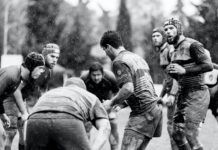In my early twenties, I was in the Australian Army for a few years as an Assault Trooper in the 2nd Cavalry Regiment. When I joined, I was super eager and ready to learn and do whatever it took to be a top-notch soldier (Trooper). As I look back now, I can see I was almost the perfect student, all you had to do was tell me and show me what to do, and I’d gladly give it a go, always at full-speed and full-effort. I just lacked any natural talent. But, with the help of my Sargent, I made it anyhow.
One thing which has remained and resonated with me over all the many years since my time in the ARMY is the teaching and training style the military used with our recruits and just how successful it was. They were able to take almost anyone from ‘civi-street’ (civilian life) and turn them into an outstanding soldier, all in just 12 weeks, with a wholly repeatable and scalable process.
If I think about what a lot of my current clients are trying to do in the business sphere, it’s precisely the same. Just replace the word soldier with sellers, and it’s the same sort of training problems and situations. Leaders are trying to create great sellers, specific to their situation from their batch of incoming recruits. Yet most businesses are only a fraction as successful as the Army. So, the question begs, what are the secrets that we can take from the military and then replicate in the business sphere?
Let me answer that by using the real-life example of how I and my platoon learnt the obstacle course as recruits in 1987.
I’m sure you can picture the situation already, barbed wire with soldiers crawling underneath, pushing their weapons through a muddy, wet pit. Unable to stand up because they are squeezed ever-closer to the ground by the tangled barbed wire roof.
There is a reason why they train soldiers to crawl under barbed-wire it’s vital in the scheme of things, and if you’ve not been in the armed forces it may not be immediately apparent, so here’s why it’s so important.
You see in battle, NO ONE gets up and runs across the battlefield as you see in the movies. It’s a sure-fire way to get shot, very quickly. If you get shot, and you’re lucky, you’re dead. If you’re only wounded, then it’s going to take 3 or 4 other soldiers to get you out of the battlefield. This scenario is the best-case for the enemy, 5 soldiers out of the action for the price of 1. Of course, if you’re dead OR wounded, you also can’t help anyone else on the battlefield. In short, YOU CAN NOT DO YOUR JOB. So, in order for you to be able to do your job, the number one thing you need to do first is NOT to GET SHOT. To be clear, as a soldier, your number one priority is not to get shot.
By training us, very early on, to crawl very low under the barbed wire the sergeants are teaching us the #1 critical skill we need to do our job.
How to move around the battlefield and NOT get shot. Because in the battlefield, under fire, you crawl everywhere, quickly. Only then can we do whatever ‘soldier task’ we’ve been trained to do to support the mission, such as blow something up, fire a machine gun of whatever.
This is essential information for soldiers, but the real value for us as sales leaders and sales managers is in the way that they teach their recruits and obtain such a high percentage of good quality soldiers at the end of the process.
Think back to the obstacle course with the barbed wire. On our very first pass under the wire, it’s set quite high, let’s say 800mm for example. It’s dry, no mud, we don’t take our guns or rifles, certainly no backpacks and even though it’s pretty easy, many of us still catch our shirts and mostly our backsides on the wire, ripping both our clothes and our skin.
We get yelled at a lot, mostly things like ‘Hurry up you squeezers. Your Mother’s not here to look after you now. Get a move on McInnes”. Not terribly supportive, this is true, but certainly creating some urgency for us to ‘act now’.
Two days later we do the obstacle course again, only this time we are to be timed, and the wire is a little lower, say 650mm high. And so a routine begins. We do the obstacle course on the way back from rifle practice, on the way to lunch, on the way back from a 20k march or on the way to PT (Physical Training)?. Lots of obstacle course practice. At regular intervals, the wire gets just a little lower, and the level of difficulty gets increasingly higher.
Before you know it, we are doing it, in the mud, in the wet, in the dark, tired, complete with our backpacks, webbing, rifles and even people firing rounds across the top of the wire to simulate battle type noises.
Let’s stop for a second and imagine if, as brand-new recruits, we had been subjected to this level of difficulty on day one? For sure someone would’ve panicked and tried to stand up and ended up caught in the wire (and shot if it was a real battlefield).
What I find interesting is, the military’s training success rate remains the same regardless of whom they are teaching. City kids, country kids, big kids, small kids, smart kids and not so smart kids, all trained in the same way and yet, out pops the same battle-ready soldier, almost every time.
If we think about training in business (or in the military), I know people generally want to be successful, people want to do well. They need the information delivered in a way which will help them make the transition from where they are now, to where they need to be. If we want our sellers to be great, we need to chunk our training down, break the learning strategies around selling into pieces where we get to practice and slowly increase the level of difficulty, incrementally. Making it much easier for people to succeed. Just like my Sargent did on the obstacle course.
We all know of those situations where the first-day seller who starts at a company, they get ‘on-boarded’ which means, here’s the HR manual, there are the fire stairs, here is our 17 principles of leadership perfection and then told to hit the phones, the social, the street, or whatever. Only to fail desperately after 5months and go to another employer. They leave with their self-esteem smashed, and both the employee and employer are the losers. #nowinners
I see it all the time. Sales skill development is not a one-time skill session thing. You can only learn a tiny piece of the puzzle in one given session, regardless of how long it is. Yet time and time again, I’m asked to provide a 4hr or 1-day workshop to help sellers upskill their sales or their social skills. Sure, I can give you an overview in 4hours, I can agitate the need for change, I can even provide some actionable strategies or motivate the team to need more, but transformational change doesn’t happen over lunch. (Unless you’re talking about a stroke or a heart attack, these two afflictions seem to make people instantly change their behaviour. I’d try to avoid these if I was you).
Recently, I ran a session for a small start-up with about 6 execs. The CEO kept questioning the social strategies saying, “yeah, great, but how can I scale that”, “How do I give that to my team in the Philippines to get 10 x activity”. I’m saying hang on a minute. You haven’t even tried these strategies as yet, and you’re already trying to find a shortcut? How can you possibly shortcut something when you don’t know how the process works? This is one of the real challenges in today’s’ B2B sales space, it’s ‘cool’ to be an entrepreneur, the language is all ‘scale up’, ‘10X Activity’, ‘Hussle’.
Here’s the truth
1 – You can’t scale up authenticity if you can’t create it one-on-one in the first place.
2 – Taking time to learn & master a skill will pay you back 10X. That’s the real 10X. When you reach out to 10 prospects and they all reply – that’s 10X. Sending 1000 messages at a measly 3% response rate is still 970 people who think you’re a jerk. Low authernticity is why automation SUCKS for 99% of the B2B sellers out there. #Avoid.
3 – Train the way we learn. The 70:20:10 learning principle works for tradespeople with tactical, tactile skills. Sales is the same. After all, typically us sellers are not the smartest people on the planet. #notrocketscience
4 – To create a real change in your selling style or your sales team, you need a sales transformation PROGRAM. Not a once of sales chat, a keynote or a motivational speaker.
5 – You cannot ‘HUSSLE’ poor performance into great results, no matter how hard you try or what time you get up #5amClub.
Figure out what your seller’s core activity is, (the sales equivalent of not getting shot on the battlefield) and get good at it quickly, by simply building a system of regular practice, call it role-play, training, rehearsal, call it whatever you want. #justdoit.
If this training process can successfully get young men (& women) to run headlong into gunfire, across 80meters of no man’s land, then I’m confident it can also teach someone to improve their outreach strategy. Or show them to make 30 calls a day, or build out a social strategy, or handle objections, or whatever, I know this because this is what successful teams do.
Lastly, DISCIPLINE it’s a dirty work in today’s, I want it now, do it later, ‘nimble it’, everyone’s a winner, society, and yet that’s precisely what will make you the star performer. Being contrary, going the extra mile, working late on real stuff, getting in early and doing the numbers and practise, practice, practice. It’s an unpopular piece of advice, I know, but if you want to be productive, successful and fashionable, these are the keys. There are NO shortcuts. #10XSUCKS






















![How [Not] To Run A Sales Meeting Stunt](https://www.headofsales.com.au/wp-content/uploads/2019/12/Stunt-1-218x150.jpg)









